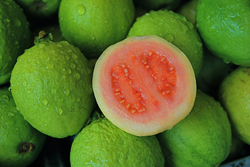The guava revolution
Brazil and Mexico are the largest producers of guava in the world, followed by Cuba and Venezuela. More than 60 % of the crop in some places is being destroyed by disease, a fact that is prompting researchers to seek solutions. The EU-funded project 'Improvement of guava: linkage mapping and QTL analysis as a basis for marker-assisted selection' (Guavamap) worked on enhancing the breeding efficiency of guava. It collected, investigated and experimented with germplasm and hybrids to produce controlled cross-varieties for production. The project team identified 11 wild psidium species that are helping create resistant varieties to the devastating nematode worm, Meloidogyne mayaguensis. Partners outlined the positive results of grafting and cross-pollination experiments in this direction using various guava cultivars. A breeding programme was initiated by the project in Cuba in order to select new cultivars. In addition, the updating of information on guava in the International Union for the Protection of New Varieties of Plants (UPOV) was also accomplished. This was followed by a thorough, specific DNA analysis, technically known as microsatellite markers or simple sequence repeats (SSR), which was undertaken to advance knowledge on growing better varieties. Quantitative trait loci (QTLs) were also analysed for different traits, including leaf size, fruit size, pulp thickness, seed numbers, nutrition and other information. The project's results were discussed at the 'Second International Symposium on Guava and Other Myrtaceae' in 2008 in Mexico. This was followed by discussions in several symposiums and conferences, with upcoming ones in Brazil and Venezuela. Now that the basics have been outlined, sustained research on guava is set to continue much beyond the project's mandate. In short, with newer varieties, prices will fall and related economies will grow.







